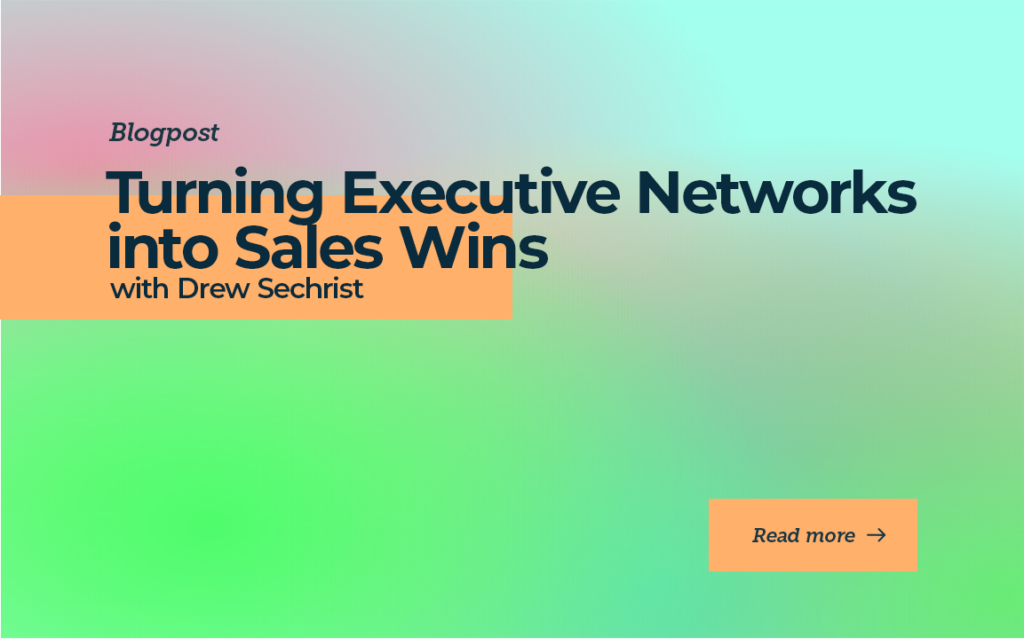Turning Executive Networks into Sales Wins with Drew Sechrist

Navigating the journey to success often hinges on leveraging strong networks and adapting to technological advancements.
This episode delves into the transformative power of building connections, exemplified by a bold, cold email that sparked a pivotal career shift. Explore the evolution of CRM solutions, the importance of the customer experience, and seamless handoffs’ critical role in maintaining sales momentum.
Learn how to harness these insights to drive your professional growth and success.
Leveraging Networks for Success
Drew Sechrist‘s journey to Salesforce began with a bold, cold email to Marc Benioff. This highlights the power of taking initiative and reaching out directly to influential figures.
Here’s the thing: Drew’s connection through Benioff’s network was more than just a lucky break. It was pivotal for his career and a prime example of how leveraging a solid network can significantly impact professional success.
Evolution of CRM Solutions
Drew’s experience transitioning from traditional on-premise CRM solutions like SalesLogix and Goldmine to Salesforce’s cloud-based model underscores a significant industry shift.
Traditional CRMs require extensive configuration, custom coding, and troubleshooting, often resulting in significant downtime and customer dissatisfaction. Salesforce’s cloud-based approach revolutionized this by offering a more user-friendly, reliable, and scalable solution.
Key Takeaway: The Importance of Ease of Use
The primary advantage Drew saw in Salesforce was its simplicity and reliability. Unlike traditional CRMs, Salesforce didn’t require complex installations or constant troubleshooting. It was easy to set up, scale, and use, making it accessible for companies of all sizes.
This ease of use was a game-changer, especially in the late 1990s and early 2000s when internet accessibility was limited compared to today.
Customer Experience and Retention
Drew’s insights reveal that a significant portion of traditional CRM business involves fixing problems rather than adding value. This strained customer relationships and diverted resources from more strategic activities.
Salesforce’s model allowed businesses to focus on growth and customer success rather than constant firefighting, enhancing overall customer satisfaction and retention.
Adapting to Technological Advancements
The conversation also touched on Salesforce’s interface evolution from its classic version to the more modern Lightning experience. While Lightning offers a sleek design and enhanced functionality, it also presents a learning curve and requires adaptation.
This highlights the continuous need for users to adapt to technological advancements and balance new features with usability preferences.
Actionable Insight for Sales Leaders
For sales leaders and professionals, Drew’s journey underscores the importance of:
- Building and leveraging strong networks for career growth.
- Embracing technological advancements that simplify processes and improve customer experience.
- Continuously adapting to new tools and interfaces to stay competitive.
Building Trust and Crafting Messages
The process required understanding Marc’s preferences and writing in a way that required no revisions. Drew emphasized that crafting these emails could take a day to ensure they were perfect. This meticulous approach built trust, making Marc confident enough to send the emails without hesitation.
Scaling with Leadership
As Salesforce grew, the strategy scaled by involving other well-connected leaders like Jim Steele. These leaders acted as executive sponsors, driving the initial meetings and lending credibility to the discussions. This approach allowed Salesforce to effectively leverage its top executives’ networks, maintaining the strategy’s success without relying solely on Marc.
Effective Meetings and Follow-Ups
Initial meetings with senior executives set the stage for deeper engagements. Marc or other senior leaders would handle the first meeting, and then the account executives would take over for detailed follow-ups and closing deals. This seamless handoff ensured the momentum built during the initial interaction was maintained.
Key Takeaways:
- Mirror the executive’s communication style for authenticity.
- Spend significant time crafting personalized, well-researched messages.
- Build a culture of leveraging relationships from the top down.
- Ensure clear handoffs to maintain sales momentum.
- Scale the approach by hiring leaders with strong networks.
This strategy drove business growth and fostered a culture of collaboration and leveraging personal connections for sales success.

The Importance of a Seamless Handoff
A key element in this strategy is ensuring a seamless handoff between the senior executive and the sales team.
Drew highlighted that while the presence of a high-profile executive like Marc Benioff was crucial for securing initial meetings, it was equally important to manage the transition smoothly.
If not handled properly, an executive’s departure could leave prospects feeling abandoned. Therefore, senior sales executives with high emotional intelligence play a vital role in maintaining engagement.
Matching Roles for Credibility
It’s not always necessary for the CEO to be the anchor. Matching the senior executive’s role to the prospect’s role can be highly effective.
For example, if selling to CFOs, leveraging your CFO to speak credibly about the product’s benefits can build immediate trust. This approach can streamline the initial call to a 15-minute introduction, during which the senior executive offers their perspective and makes themselves available for future questions.
This reassures the prospect that they are anchored at the right level within your organization.
Utilizing Board Members and Advisors
Beyond internal executives, leveraging external figures such as board members and advisors can also be impactful. Investors, in particular, can use their networks to provide strong endorsements.
For instance, a well-placed note from an investor can significantly tip the scales in favor of closing a deal incredibly late in the funnel. This endorsement acts as a robust validation of the product and the company.
Crafting Effective Ghost Emails
Brevity and precision are paramount when ghostwriting emails for senior executives. These executives typically do not have the time to read long emails, so it’s essential to convey the message in three to four sentences.
Tools like Lavender can help refine and shorten the message, ensuring it’s punchy and to the point.
Knowing the relationship between the senior executive and the recipient is also crucial. The email should reflect the writing style and tone that the executive would naturally use. If the executive has a particular way of writing or preferred templates, sticking to that format can save time and maintain consistency.
Standardizing Templates for Scale
Creating standardized templates for different senior executives can help maintain consistency and efficiency as organizations grow. These templates should be approved by the executives and used for highly targeted introductions.
While the core message remains the same, personal touches can be added based on the executive and recipient relationship.
The Impact of Executive Relationships
Drew explains that integrating executives and board members into your sales outreach can significantly improve meeting booking rates. By leveraging their networks, you can access high-level contacts more efficiently.
Key Insights:
- Strong Relationships: Utilize the strong relationships your executives and board members have to reach key decision-makers.
- Efficient Use of Time: By making the process quick and easy for your executives, you ensure they are more likely to participate actively.
The CEO’s Time Dilemma
CEOs like Marc Benioff juggle numerous responsibilities, making even small tasks like sending emails a significant time drain. Drew Sechrist highlights the importance of streamlining such tasks to maximize efficiency.
Key Insights:
- Volume Matters: CEOs may need to send multiple emails daily. Even two minutes per email can add to a substantial part of their day.
- Efficiency Boost: Reducing email time from minutes to seconds allows CEOs to maintain high productivity without sacrificing quality.
The Impact of Automation
Automating the process of sending ghost emails through tools like Connect the Dots significantly enhances efficiency. This approach ensures emails are quickly dispatched while maintaining a personal touch.
Benefits:
- Rapid Execution: Automation reduces the time required to send an email to just a few seconds.
- High Leverage: CEOs can focus on strategic tasks, knowing their outreach is handled efficiently.
Real-World Application and Outcomes
Companies have seen impressive results by employing this method. Drew shares that using Connect the Dots has led to a 38% meeting booking rate and a 30% success rate for meetings with C-level executives.
Performance Metrics:
- Increased Meetings: High meeting booking rates demonstrate the effectiveness of leveraging executive influence through automated emails.
- Consistent Success: Regularly securing meetings with top executives highlights the reliability of this approach.
Joining Connect the Dots
Connect the Dots offers a beta program and free accounts for adopting this efficient strategy, allowing users to experience the benefits firsthand.
Getting Started with Predictable Revenue
Ready to revolutionize your sales strategy? Visit our website to learn more about our proven methodologies and start transforming your sales process today!
NO TIME TO READ?
Listen On:




